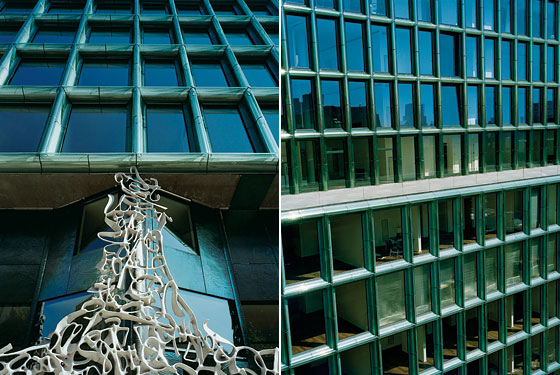
New York was once a city of fancy façades. Terra-cotta tiles, brownstone fronds, limestone gargoyles, cast-iron pilasters: All these genteel encrustations served to advertise someone’s ability to pay for them—at least up through the thirties. Then came postwar modernism, which preached the sanctity of simplicity, a sermon from which we are still recovering. Richard Meier’s recent glass palazzi in the West Village and the one still under construction on the edge of Prospect Park are practically godly in their purity. The chic-est cladding a building can wear is as transparent as the emperor’s outfit.
Enter 40 Bond, a touchably textured new condominium in Noho ordered up by the hotelier Ian Schrager and designed by the Swiss firm Herzog & de Meuron. Instead of using glass in diaphanous sheets, they have molded it into thick, viscous-looking bottle-green tubes that frame the separate windows. Architects in these parts design in shackles, since the zoning code defines the building’s form, but by sculpting the surface in cast-glass relief, Herzog & de Meuron have defied the blankness of the curtain wall. It’s a gesture that makes itself felt on the inside, too: The windows actually open, and the frames give an aqueous halo to the view onto the street.
The lavishness goes on. A giddily ornate gate made of cast-aluminum curlicues acts as the Manhattan version of a picket fence, delimiting a sliver of front yard. This burst of exuberance recalls a Moorish screen, or the grille of a Spanish Baroque cathedral, or the insanely organic forms with which the Catalan architect Antoni Gaudí festooned Barcelona. The doodle pattern runs wild on every surface: the steel façade panels at street level, the wooden cigar box that houses the concierge desk, the lobby’s reflective steel ceiling.
Herzog & de Meuron, who won their profession’s ultimate laurel, the Pritzker Prize, in 2001, are virtuosos of the tactile exterior. They swathed the de Young Museum in San Francisco in nubbly copper and wrapped the Walker Art Center in Minneapolis in crinkly metal. Their buildings make you want to run your fingers over them. Here, in the firm’s first New York City project, that sensual richness acts as a more or less explicit come-on. Imagine, the façade murmurs, what splendors lie within. The narrow lobby—a passageway, really—takes the erotics of real estate a shade too literally: Enter, and you are squeezed between fleshy folds of Corian, ribbed with those ubiquitous organic patterns.
Schrager has built a career on the irresistibility of design, and here he has gambled that a handful of multimillionaires will choose to live in the five townhouse-style units on the ground floor, which might otherwise house stores or restaurants. (There are 27 units in all, and the developer himself will eventually move into the building’s upper stratum: a triplex penthouse, plus a glass house on the roof.) I’m not sure what kind of private pleasure dome would seem like a good deal at $10 million, but my pulse did not quicken nor my tongue go dry at the sight of the two-story townhouse behind the extravagant gate. It’s nice that the floor, lined with wide smoked-oak planks, runs up the kitchen walls, disguising refrigerator and cabinets. And sure, the backyard that would seem impoverished in most of America looks practically majestic here. The staircase snakes charmingly up to the bedroom level, though the views from those generous windows are mostly of the neighbors gazing right back. But the real action takes place back on the street. For those of us who don’t actually live there, the main virtue of those private spaces is that their generous volumes and quirky nooks help shape the idiosyncratic exterior.
The two-block stretch between Broadway and Bowery is being refashioned day by day. A new limestone checkerboard façade across the street is nearly finished, and Deborah Berke’s stylishly classic, charcoal-gray condo at 48 Bond will give the neighborhood a touch of Joseph Abboud flair. But neither can compete with the bravado of Schrager’s new bauble, and the way it reframes the language of gentrification. Herzog & de Meuron claimed to have reinterpreted a local type, the cast-iron building, though with other materials, and what 40 Bond lacks in iron, it makes up for in irony. Take the proliferating, abstract pattern of the gate, a three-dimensional, computer-generated elaboration of graffiti on a city wall. It’s meant to be a reference to the neighborhood’s grittier days, but in post- Giuliani New York, it’s rare to find a whole side of a building covered with those bright rococo flourishes. So Herzog & de Meuron’s street-cred scouts had to hit the streets of Basel to supplement their source photographs. You know the city has changed when you have to import graffiti from Switzerland. Then there’s the way this design takes an individual’s (or a gang’s) mark on the urban canvas and makes it anonymous and abstract—a scrawl without a wall, a signature without a signer. The gate also represents the endpoint of a process of commercialization. First, graffiti became graffiti art, the ownable version that hung in the parlors of the hip. Now Herzog & de Meuron have moved the stuff back outdoors and attached it to the ultimate consumer product: the condominium.
If I were an antisocial teenager with a spray can, the new building would make a deliciously poetic target. You enjoy graffiti, Schrager? Fine: Have some of the real thing. And anybody caught defacing the gate would be able to face a judge with the perfect rhetorical defense: It’s not vandalism, Your Honor; it’s a commentary on the aesthetics of appropriation.
